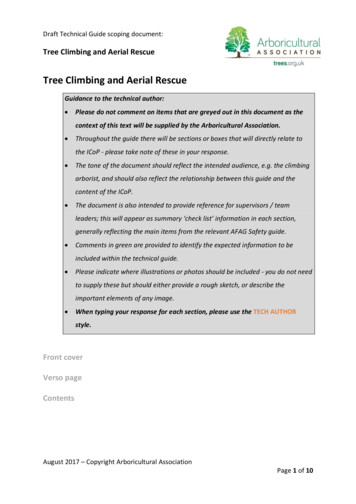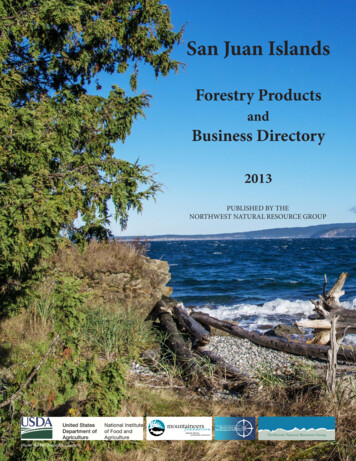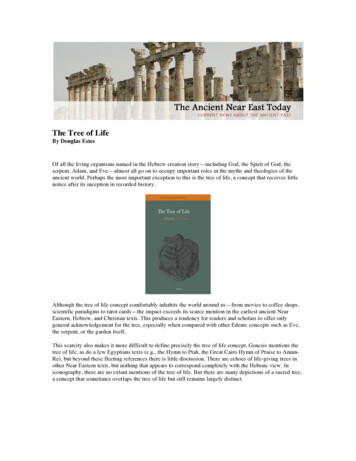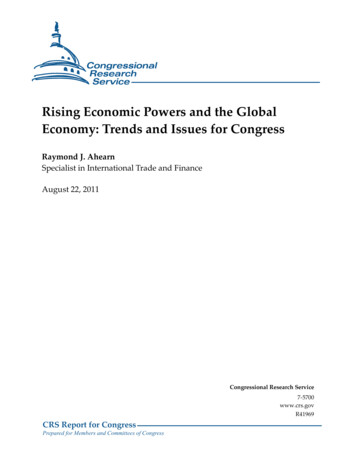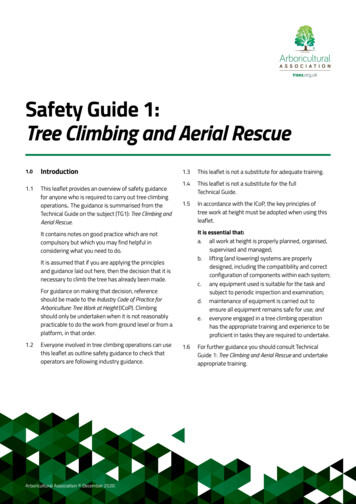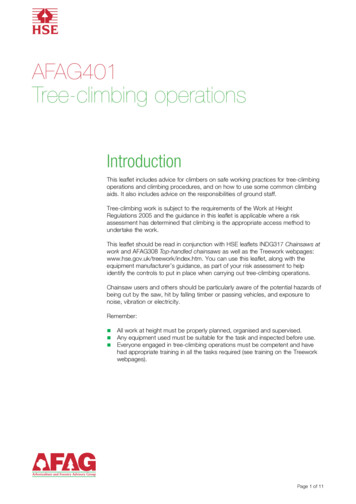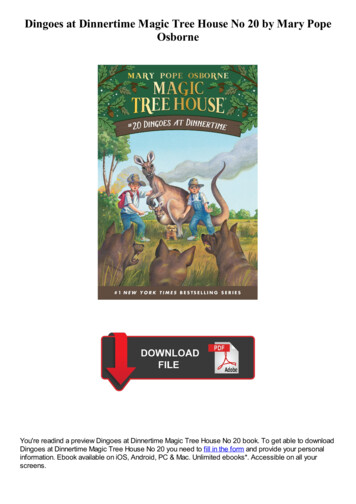
Transcription
P S YC H O S O C I A L W E L L B E I N G S E R I E STreeof LifeA workshop methodology forchildren, young people and adultsAdapted by Catholic Relief Services with permission from REPSSIThird Edition for a Global Audience1
REPSSI is a non-profit organisation working to lessen the devastating social andemotional (psychosocial) impact of poverty, conflict, HIV and AIDS among childrenand youth. It is led by Noreen Masiiwa Huni, Chief Executive Officer. REPSSI’s aim isto ensure that all children have access to stable care and protection through qualitypsychosocial support. We work at the international, regional and national level inEast and Southern Africa.The best way to support vulnerable children and youth is within a healthy family andcommunity environment. We partner with governments, development partners,international organisations and NGOs to provide programmes that strengthencommunities’ and families’ competencies to better promote the psychosocialwellbeing of their children and youth.A clear objective of the REPSSI tools for the Psychosocial Wellbeing series – ofwhich Tree of Life is a part -- is to strengthen children’s sense of belonging andconnectedness to their families and communities, as well as to challenge the senseof isolation and loneliness that many children experience in the context of disease,poverty and conflict.Catholic Relief Services (CRS) was founded in 1943 by the Catholic Bishops ofthe United States to serve World War II survivors in Europe. Since then, we haveexpanded in size to reach 100 million people annually in over 100 countries on fivecontinents.Our mission is to assist impoverished and disadvantaged people overseas, workingin the spirit of Catholic social teaching to promote the sacredness of human lifeand the dignity of the human person. Catholic Relief Services works in partnershipwith local, national and international organizations and structures in emergencyresponse, agriculture and health, as well as microfinance, water and sanitation,peace and justice, capacity strengthening, and education. Although our missionis rooted in the Catholic faith, our operations serve people based solely on need,regardless of their race, religion or ethnicity. Within the United States, CRS alsoengages Catholics to live their faith in solidarity with the poor and suffering peopleof the world.We hope that, in this expanded edition, the Tree of Life will help many people andorganizations around the world in their efforts to improve the wellbeing of children.Email: knowledge@repssi.org Website: www.repssi.org Telephone: 27 11 998 5820 Postal address: PO Box 1669, Randburg, 2125, Johannesburg, South Africa
ContentsAcknowledgementsPart 3Storms of Life273Animals in the forestTaking the lessons home3032Part 1Creating our trees12Preparing for part oneParticipants draw and share their treesRoots of the treeThe groundThe trunk of the treeThe branches of the treeThe leaves of the treeThe fruits of the treeThe ‘Telling’121517181920212223Part 4Our Trees / Our Lives33Certificates and Tree of Life songPreserving our beautiful trees3436APPENDIX 1: Energisers37APPENDIX 2: Questions for Tree of Life38APPENDIX 3: References40Part 2Forest of Life24Making the forest25Introduction2
AcknowledgementsLike a real tree, the Tree of Life has grown bigger and more wonderful overthe years.Sincere appreciation also goes to Hope World Wide South Africa - now Olive LeafFoundation - and its staff and counsellors who displayed amazing enthusiasmin embracing new ideas, demonstrating their desire to provide meaningfulsupport to the children and communities that they serve. Substantive input forthe REPSSI publication of the Tree of Life was provided by Ncazelo Ncube-Mlilo,Jonathan Morgan, Noreen Huni and other REPSSI colleagues.Anne Hope and Sally Timmel published a version of the Tree of Life in 1984 intheir book: ‘Training for Transformation: A handbook for Community Workers,Book 1. Mambo Press, Senga Press, Senga Road, Gweru.That version was further developed and expanded by Ncazelo Ncube-Mlilo(REPSSI) and David Denborough (Dulwich Centre Institute of CommunityPractice). Sincere appreciation goes to the Dulwich team, David Denborough,Michael White, Cheryl White and Shona Russell, for their encouragement andguidance throughout the shaping of the Tree of Life project. The Tree of Lifemethodology with narrative ideas was first published in the International Journalof Narrative Therapy and Community Work in 2006.Revisions for the current “Third Edition for a Global Audience” were preparedby Lucy Y. Steinitz of Catholic Relief Services (CRS) based on input from a Tree ofLife “Training of Trainers” workshop in June, 2016 in Chennai, India that was cofacilitated by REPSSI’s Lynette Mudekunye and Alex Tigere. Many thanks to the“Combatting Trafficking in India” project of CRS that sponsored that workshopand to all the participants and reviewers in India (Jomey Joseph, project lead)who provided input and support for the current adaptation of this manual.This collaboration between CRS and REPSSI has been a joyful process thatwe believe will help many more trees sprout – and will help many more youngpeople improve their lives wherever they happen to be.Many thanks go to the Salvation Army Masiye Camp team over the years for theiropenness and willingness to share their experiences, including their successesand challenges of working with distressed children. Their experiences, alongsidethe stories that the children willingly shared, provided the impetus and motivationthat led to the development of the Tree of Life methodology tool.2
IntroductionWhat is the Tree of Life?The Tree of Life is a psychosocial support tool based on narrative practices.It is a tool that uses different parts of a tree as metaphors to represent thedifferent aspects of our lives. It involves people drawing their own ‘Tree of Life’in which they get to speak of their ‘roots’ (where they come from), their skillsand knowledge, their hopes and dreams, and the special people in their lives.The participants then join their trees into a ‘forest of life’ and, in groups, discusssome of the ‘storms’ that affect their lives and ways that they respond to thesestorms, protect themselves, and each other. The use of metaphors and carefullyformulated questions invites children and others to tell stories about their livesin ways that make them stronger and more hopeful about the future.While it was not designed for catharsis or as a bereavement tool, the Tree ofLife opens up space to facilitate conversations about hardship, bereavementand loss. It has been used extensively for this purpose with children in manydifferent contexts. The Tree of Life experience allows children and adults whoare severely affected by disease, poverty, violence and conflict to tell, hear, andexplore stories of loss without remaining trapped in expressions of negativityor grief. It simultaneously opens up spaces and opportunities to tell, hear andexplore stories of hope, shared values and connection to those around them aswell as to those who have died.Participants often report a deeper sense of belonging, identity and innerconfidence after completing a Tree of Life workshop. Through this edition,we hope to extend the experience to an even broader array of contexts, forexample in the aftermath of war, humanitarian crises and exploitation.3
Who developed the Tree of Life, and why?Who can benefit from the Tree of Life?The Tree of Life methodology was co-developed through a partnership betweenREPSSI in southern Africa (www.repssi.org) and Dulwich Centre Foundation inAustralia (www.dulwichcentre.com.au). Ncazelo Ncube (REPSSI) and DavidDenborough (Dulwich Centre Foundation) initially developed this Tree of Lifeapproach to assist colleagues who work with children affected by HIV/AIDS insouthern Africa. This approach has proved so successful and popular that itis now being used with children, young people, and adults in a wide range ofcountries across Africa as well as in Australia, Brazil, Canada, Russia, India, Nepal,the USA and elsewhere. The current edition is intended to further expand theTree of Life’s global reach. It was adapted by Lucy Steinitz and her colleaguesat Catholic Relief Services, following a training workshop by REPSSI in Chennai,India in June, 2016.The Tree of Life has been used to support: Young people affected by HIV and AIDS, and by extreme poverty Children in school and other social settings where they spend their time,for example, in community-based safe-spaces or children’s clubs Paraprofessionals working with groups of children affected by conflictand war Children who have lost parents or other loved-ones due to armed conflict Refugees and immigrants People whose communities have suffered from a natural disaster Young people and adults, especially women, who have experienceddomestic violence, abuse, trafficking or other forms of exploitation Mental health practitioners working with adults who are experiencing mentalhealth strugglesThe Tree of Life helps participation avoid re-traumatisation (sometimes calledsecondary traumatisation) that can be caused by the retelling of the originaltrauma without the appropriate support. By contrast, the Tree of Life enablespeople to speak about their lives in ways that are not retraumatising. Instead,the Tree of Life helps participants strengthen their relationships with their ownhistory, their culture, and significant people in their lives in a positive way.The Tree of Life may also be used as a counselling tool in shelter homes or inconjunction with one-on-one counselling by trained professionals. Adults havealso engaged in a Tree of Life workshop and found it meaningful, both for theirown lives and in their role as parents or caregivers of children.The Tree of Life was originally designed for children and young peopleaged between 5 (five) and 20 (twenty) years. However, this does not meanthat the process cannot be adapted for use with older participants. Manyadults - especially secondary caregivers who work with children - have foundmaking their own Tree of Life to be an invigorating and enriching experiencethat allows them to feel deeply connected to other people in their lives.Adults who have completed their own Tree of Life have said that they havefound this to be supportive and sustaining in their work with children andThe Tree of Life utilizes metaphors, which in many cultures and communitiesevoke powerful meanings and associations for the local people. These meaningsand associations embrace important values, skills and knowledge about life.These values, skills and knowledge can support people to find answers to theirproblems and challenges. In the various contexts where the Tree of Life toolhas been used, people have engaged easily with the tool due to the appealingnature of the metaphors that are associated with it.4
communities in crisis. Before a counsellor takes a group of children throughthe Tree of Life, they are required to make their own Tree of Life to familiarisethemselves with the process.How does the Tree of Life support children and adults?Tree of Life helps provide psychosocial support; that is, the emotional healing,spiritual strength and meaningful expression that help people recover from loss,trauma and other types of hardship. Psychosocial support includes love, care,protection and life-skills. Generally, psychosocial support is best provided byfamilies and communities, although others can also help - for example throughworkshop tools like the Tree of Life.There are different levels of psychosocial support, as illustrated by the diagrambelow. Add this diagram back in from the original text or draw it again. The Treeof Life most often targets Advocacy, the Provision of Basic Services and Familyand Community Support (the first, second and third levels below). By contrast,focused and specialized support (the fourth and fifth levels, or cases of moresevere need) are usually identified elsewhere in the community, to be calledupon if needed.5
Multilayered, Integrated Psychosocial SupportFEW SEVERLY AFFECTED CHILDRENLevels of Psychosocial Support (PSS)5. Specialised Mental Health Services:5.SPECIALISEDMENTALHEALTH SERVICESPsychiatric, clinical psychological, specialised traditional healerservices for the few children with more severe responses4. Focused Support:4 . FO CUSE DSU PP O R TAdditional non-specialised support for children who are notcoping and who are showing signs of distress3 . FA M ILY &CO M M U NIT YSU PP O R T3. Family and Community Support:Everyday care and support provided by caregivers, friends andcommunity members2. Provision of Basic Services:2 . PROV ISI O N O F BA SI C SER V I CE SShelter, food, health and education, into which PSS needs tobe mainstreamed, to reach many children and support waysof coping1. A D V O C A C Y1. Advocacy:Influencing policy and changes to the social conditions thataffect the wellbeing of millions of childrenALL CHILDRENAdapted from Inter Agency Standing Committee, 20076
The Tree of Life is rarely used as a stand-alone intervention. It can – andshould --be integrated with other activities that enhance individual and familywellbeing. These additional activities may be offered by the same organizationthat facilitates the Tree of Life, or else by another provider, for example by aschool, health centre, or government social services.The Tree of Life experience invites participants to step into a therapeuticprocess by initially exploring the precious things about their lives. This includestheir family history, important relationships, skills and competencies, as wellas other things of which they are proud. All of this is done before discussingproblems. Starting the process by first exploring the good and positive aspectsof the participants’ lives challenges the feelings of hopelessness, desperation,depression and defeat. Although no one should deny that bad things thathappen, it is important to emphasize the positive in order to build strength andemotional resilience for the future. By the end of the workshop, the intent is forparticipants to feel more empowered, positive and hopeful about their lives.How does the Tree of Life focus on positive things?Narrative practices place emphasis on ensuring safety when working withchildren, individuals and communities. This refers to “emotional safety” aswell as physical safety. Safety can be compromised in counselling by askingthose who are experiencing problems to continuously retell problem-saturatedstories (stories that focus only on problems and pain). Many of the participantsin a Tree of Life workshop might have been asked to talk repeatedly abouttheir experiences of trauma and suffering. This is harmful and potentially retraumatising. These stories are devoid of hope and may be thought of as the“first story”.Tip: Avoid upsetting questionsThe expression “to open a can of worms” is one with which most counsellorsworking with troubled children and groups are familiar. Often in counsellingcontexts, counsellors realise that they have asked someone a question thatseemed very simple and straight forward, but has led to a very emotionaland painful response. That response may be one that the counsellor is notprepared for and, at most times, one that the child or individual is unableto contain (hence the expression, “opening up a can of worms”). Whenthis occurs, sometimes other members of the group may also join in withtheir own tears, pain and distress. Such experiences are re-traumatising forindividuals seeking counselling support and can also be difficult, challengingand disheartening for counsellors. Because of this, care should be taken inadvance to avoid any potentially upsetting question that may lead to markeddistress in the child or individual concerned.The Tree of Life tool is deliberately designed to support participants intoexploring the “second story” of their lives. The second story is about the skills,hopes and dreams that an individual has for his or her life. It is an encouragingand invigorating re-telling that provides a firm base for someone to proceedwith life, despite the problems that he or she could be facing. Without theTree of Life, these stories rarely get told and celebrated in the community or incounselling contexts where the focus is usually on the negative issues.7
The Tree of Life is designed to offer a safe space for participants to revisit someof the difficulties that they have experienced in their lives, but in a way that doesnot further traumatise them. The Tree of Life allows children and adults facingchallenges to create a distance between themselves and the problems, therebyenhancing their feeling of control and self-efficacy. Furthermore, the Tree ofLife tool deliberately avoids asking individual children to share details abouttheir personal problems and circumstances in the group context. This can bevery unsafe, particularly where there is an obvious lack of follow-up services forindividual children.also given the opportunity to write a letter or draw a picture of appreciation toan individual or individuals who have especially supported them. It is hopedthat this will enable caregivers and families connect in important ways toparticipants’ experiences, as part of the support process.How should counsellors be selected?The quality of the Tree of Life experience depends in large part on the sensitivityand support provided by the counsellors who facilitate the Tree of Life process.It is not necessary to have a university degree for this purpose. Over the years,we have learned that religious leaders, teachers, NGO staff and volunteersoften make excellent facilitator-counsellors of the Tree of Life methodology,provided they are trained in the methods. More than one’s formal education,what matters is the counsellor’s caring personality, good listening and facilitationskills and positive attitude. That said, the lead counsellor should have at leastsome previous training in psychosocial care and support or be very familiar withthe values and principles thereof.During the Tree of life experience, only commonly experienced problemsare shared with the group and the solutions to problems are discussedcollaboratively. The emphasis here is on common problems. Participants shouldbe supported to see that they are not on their own, but rather that they belongto their families, communities, peer groups etc. This challenges the sense ofisolation and loneliness often felt by people who have experienced severedistress and trauma. Strengths are identified and positive solutions are sought,wherever possible.REPSSI has found that the optimum ratio of counsellors to participants is 1:3, orwith experienced counsellors, 1:4 or 1:5. Although this may be difficult, the pointis that one counsellor should always be close at hand when each participanttells her or his story (i.e. the oral narrative).How does the Tree of Life strengthen relationships?The Tree of Life process deliberately invites participants to reflect, honour andacknowledge the precious relationships that they have with their caregivers,families, peers, community members etc. This is especially important whenthe participants are young. At the end of the workshop, participants are givena certificate to take home that acknowledges their active participation in theTree of Life workshop. This ceremony and these certificates also honour thecontributions of important people in the lives of participants. Participants areThe absolute minimum number of counsellors is 2 at every Tree of Life workshop.With just 2 counsellors, the workshop may take more time. One counsellor maybe designated the “lead” and the other may focus on providing one-on-onesupport, if needed. Counsellors should assist each other and also providesupport to participants who may need one-on-one attention or help with8
writing. Because of these different roles, the terms counsellor and facilitator areused interchangeably in this manual, although the word counsellor is generallypreferred.If the Tree of Life workshop is extended to more than one day, the break shouldoccur between two different parts.Counsellor training is best achieved by going through the experience of makingone’s own Tree of Life; that is, by actively participating in a Tree of Life workshopled by others. It is preferable for a trainee to undergo the experience of being aparticipant more than once. A new counsellor should be matched with a moreexperienced counsellor at least a few times before taking the lead role.The use of culturally appropriate metaphorsTrees are generally found in most communities in the world and they areusually associated with life, nourishment, shelter, strength, security, healingetc. But where there are few trees (for example, in a desert country) or forestsare associated with danger, a different metaphor may be introduced (e.g. a“garden” instead of a forest). It is essential that the ideas and methods used incounselling fit with the local culture and context. Failure to merge facilitationpractices with local culture is an imposition and not helpful to the children andadults seeking support.How long is the Tree of Life workshop?The Tree of Life workshop generally takes 8 hours (one full day) to complete,although some counsellors have reported taking longer (up to two days). Thelatter may occur if all participants tell the story of his or her Tree of Life in detailor if there are just 2 counsellors available.Consent/ assent formsFor children to participate in this workshop, it is often required that their parentsor legal guardians give their consent. This may require a separate meeting wherethe purpose and process is explained, before they are asked for their signedagreement (i.e. with a signature or thumbprint). Children may also be asked tosign their assent to participate in advance. Signed consent/assent forms shouldbe kept by the facilitating organisation.For the one-day workshop, Part One is estimated to take 4-5 hours (that is, anentire morning), while Parts Two to Four can take a little less time in total – 3-4hours (an afternoon).Because Tree of Life is a full-day four-part exercise, there is a need for mini breaksand “energisers” between the different parts. This allows the counsellors andparticipants to “catch their breath” and remain energised through the process.No set time is established for this, but counsellors should break when theyfeel that energy is flagging or the atmosphere has gone too heavy. Suggestedenergisers are included at the back of this manual, or participants may offertheir own.9
What materials are needed?How should the workshops be organised? One large flip chart sheet-of-paper for each participant. Alternatively, usebutcher papers or light-coloured cardboard paper. Smaller paper for writing letters (or drawing a picture) to significant others. Colourful writing materials such as crayons, paints (food colouring works asreadily available and inexpensive paint), flipchart markers etc. Pencils andpens are also required. Handmade certificates for each participant. Tape or sticky material to paste the participants’ pictures on the walls. The ideal number of children for a Tree of Life workshop is twelve (12). Withyoung children aged 5-7 years, the group should be smaller (10 children atmost) and the number of counsellors should increase. With older children oradults, the group can be somewhat larger (up to 16), with fewer counsellors. Remember that at least one facilitator – preferably more, especially withyounger children – should be able to serve as a support counsellor to provideone-on-one support, referral and follow-up, if needed. Age cohorts should be kept separate – there should not be a mix of youngeror older children or children with adults. Genders can be kept separate or can be mixed, depending on the local cultureand the type of trauma that many of the participants have experienced. Forexample, for survivors of trafficking or sexual abuse, separating female andmale participants is important. Most older children and adults will be able to write down their thoughtsas well as draw their Trees of Life. Younger children and others with lowliteracy should be asked if they want a counsellor to write down what theysay about their Trees of Life on the paper next to their drawing. If they wantthis assistance, the counsellor should only write what he or she is instructedto write by the participant. The lead counsellor should adequately brief the others about the processand the support that they will need to provide during the workshop. Thesupport counsellor(s) should know in advance about local resources thatmight be available to help children who experience a lot of distress. If thereis any sensitivity that might need special attention, they should also bediscussed beforehand so that the counsellors can plan accordingly. Certificates should be prepared prior to the workshop, except for filling inthe participants’ information.10
Snacks and refreshments should be available for participants, as the processis a long one. A list of energisers should be ready for use during the exercise (see Appendix 1) Plan a song that the group can sing when certificates are issued. Askparticipants for ideas for a song. Consider inviting parents, caregivers, friends, and community membersto witness the certificate ceremony at the end of the process. Use theparticipants’ local language as much as possible. For example, you may say, “The Tree of Life is an activity in which peopledraw a tree on a big piece of paper. We draw the roots, the ground, thebranches, the leaves and the fruits. We ask you to imagine that you are atree and what it would be like to think of parts of your life as parts of a tree.For example, the roots are where you come from. And the branches are yourhopes, dreams and wishes. And the leaves are important people that havebeen or are in your life”. Explain that all participants will be invited to draw a Tree of Life, and get achance to share their drawing and their story, if they want to. Present your own Tree of Life that you have prepared previously (perhaps,when you were in training as a facilitator). Alternatively, if you have examplesof other Trees of Life from previous workshops (that the creators gave youpermission to show) share these with the children to give them a good senseof where they are going. But be sure that others don’t copy from these – soonce you have shown them, put them away again. Tell the children that if they do not want to participate, that it is okay. No oneshould be forced to do any of the exercises. Allow time for questions and discussion. Once you have managed to draw the interest and attention of the children,invite them to spend the day together with the counsellor and create theirpersonal Trees of Life.Introducing children to the Tree of Life experienceRather than be prescriptive and providing rules for introducing the Tree of Lifeprocess to children, counsellors are encouraged to plan their own introductionto the workshop. Counsellors are encouraged to be creative, innovative andlocally appropriate.Here are some suggestions to consider when talking directly with children.These may be adapted for adults. Begin the process by explaining to the children that they have come togetherto support and provide each other with encouragement using the Tree ofLife method. Lead a short discussion about trees in general. Children are usually keento show and share their knowledge about trees. They may talk about thedifferent kinds of trees that they know and see in their communities, etc. Ask the children to talk about the different parts of the tree (trunk, roots,branches, leaves, fruits) and also about forests of trees. Explain that the purpose is to make a Tree of Life and to give each othersupport.At the beginning of each Tree of Life workshop, counsellors should also initiatea discussion about confidentiality with all participants. Remind the participantsthat personal information that was said and heard in the group remains inthe group. Counsellors should provide examples of what is appropriate andinappropriate to share outside the group.11
Creating our treesPART 112
Preparing for part onePart OnePrior to the workshop, the counsellors must make a decision related to theway they want to implement the telling or sharing of participants’ stories, whichis an important part of the Tree of Life experience. This activity begins in PartOne of the workshop, which works as follows:Draw the whole tree first, in responseto prompts.All participants should draw the entire tree first, starting with the roots andthe ground, following the counsellor’s prompts. With this approach* all thedrawing occurs first and the writing takes place later when the counsellor asksthe participants to add words (a short narrative or some additional drawings)to each part of the tree. Remember that participants who are not comfortablewriting (perhaps because they are too young or semi-literate) may need helpputting words to paper on their trees. This is important because detailed writinghelps the counsellors retell rich, believable stories later in the day.When this is finished, each person shares (tells) about the whole tree that sheor he has made. In total, Part One of the workshop s takes between 4-5 hours,including breaks (lunch, snacks). This breaks down as follows:Afterwards, add the writing toeach part of the tree. After that iscompleted, each person shares (tellsother participants) what she and he hasincluded in their whole tree (startingfrom the roots).Each person shares what she andhe has included in their whole tree(starting from the roots). This activity isthe Telling of the story, which can occurin front of the whole group or in smallgroups.13Time (approx.)1 hour1 – 1½ hourswith breaks in between2 hourswith brea
2 Acknowledgements Like a real tree, the Tree of Life has grown bigger and more wonderful over the years. Anne Hope and Sally Timmel published a version of the Tree of Life in 1984 in their book: ‘Train



